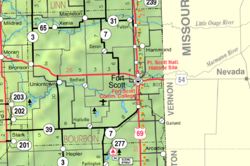Fort Scott, Kansas
| Fort Scott, Kansas | |
|---|---|
| City | |

Downtown Fort Scott (2006)
|
|
 Location within Bourbon County and Kansas |
|
 KDOT map of Bourbon County (legend) |
|
| Coordinates: 37°50′7″N 94°42′7″W / 37.83528°N 94.70194°WCoordinates: 37°50′7″N 94°42′7″W / 37.83528°N 94.70194°W | |
| Country | United States |
| State |
|
| County | Bourbon |
| Area | |
| • Total | 5.59 sq mi (14.48 km2) |
| • Land | 5.55 sq mi (14.37 km2) |
| • Water | 0.04 sq mi (0.10 km2) |
| Elevation | 846 ft (258 m) |
| Population (2010) | |
| • Total | 8,087 |
| • Estimate (2012) | 7,934 |
| • Density | 1,457.1/sq mi (562.6/km2) |
| Time zone | Central (CST) (UTC-6) |
| • Summer (DST) | CDT (UTC-5) |
| ZIP code | 66701 |
| Area code(s) | 620 |
| FIPS code | 20-24000 |
| GNIS feature ID | 0474788 |
| Website | fscity |
Fort Scott is a city in and the county seat of Bourbon County, Kansas, 88 miles (142 km) south of Kansas City, on the Marmaton River. As of the 2010 census, the city population was 8,087. It is the home of the Fort Scott National Historic Site and the Fort Scott National Cemetery. Fort Scott is named for Gen. Winfield Scott.
Established and garrisoned by the U.S. Army from 1842–1853, soldiers at Fort Scott assisted with the protection of the Permanent Indian Frontier. After the army abandoned the fort in 1853, the buildings were purchased by local settlers at a government auction in 1855. Fort Scott was laid out as a town in 1857.
Between 1855 and 1861, the citizens of Fort Scott experienced the violent unrest that preceded the American Civil War on the Kansas and Missouri border. Eastern newspapers described this violence as "Bleeding Kansas", a result of the national controversy concerning the extension of slavery into the new territories. Murder, rape, mayhem, robbery, and arson were committed by bold free-state and pro-slavery advocates in the name of their cause. On January 29, 1861, Kansas entered the union as a free state, but the turmoil of "Bleeding Kansas" continued throughout the Civil War.
During the Civil War, Fort Scott was a U.S Army district Headquarters, quartermaster supply depot, training center, and recruitment station. It was strategically vital to the defense of Kansas and the Midwest. A battle over the fort occurred in August 1861 just across the Missouri line in the Battle of Dry Wood Creek. The battle was a pro-South victory for Sterling Price and his Missouri State Guard. Price did not hold the fort and instead continued a northern push into Missouri in an attempt to recapture the state. James H. Lane (Senator) was to launch a Jayhawker offensive behind Price from Fort Scott that led to the Sacking of Osceola. The ill will of these actions was to be the basis for the 1976 Clint Eastwood film The Outlaw Josey Wales.
...
Wikipedia
